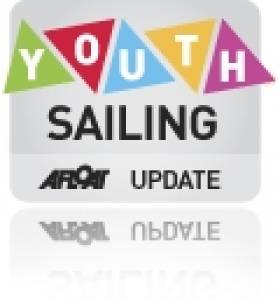Displaying items by tag: ISORA
#isora – The Race 3 of the ISORA Avery Crest Offshore Series was very special as it was the first time that an ISORA Race was to be recorded using Yellow Brick (YB) satellite trackers that featured on Afloat's home page live during the race from Dun Laoghaire to Holyhead on Saturday. This 'huge step' for ISORA was facilitated by the generous sponsorship of "Avery Crest Ski Chalets Meribel" writes Peter Ryan, Chairman ISORA. Overall results after three races are available to download below.
The sponsorship allowed ISORA to acquire YB trackers to be used in all their races in the future. The use of the trackers brings the challenges and progress of offshore racing "right into your sitting room". In the past the fleet headed off from the start line and disappeared over the horizon, out of sight and unfortunately, out of mind. Now with the superb quality product, YB Trackers, all the boats taking part can be tracked and their progress followed by those left behind. As part of this leading tracking system, people can now download the YB Tracking app and buy the entire ISORA 2015 series of races for €2.99. All races can be replayed and analysed after the race in the comfort of your own home.
Of the 18 entries for the race, 17 came to the start line where National YC Commodore, Larry Power, sent the fleet off direct towards Holyhead at 08.05. The weather forecast for the race was not good since the beginning of the week. Earlier in the week the race promised to be run with very strong winds. However, as the week developed, a window of opportunity opened in the forecast to allow nearly perfect conditions for the race. This window was to close by early Sunday morning when again strong southerly winds were expected on the Irish Sea. With this limited window of opportunity available, the Sailing Committee decided to shorten the course to go direct to Holyhead.
![]()
A screenshot of the ISORA fleet race trackers used for the first time in Saturday's race from Dun Laoghaire to Holyhead. Click here for more
At the start, the winds were North westerly 10-12 knots. The forecast showed that a hole of "no wind" would develop close to the Irish coast by mid-day and it was vital that the fleet made progress away from the land immediately after the start. The fleet, lead by the Adrian Lee's Cookson 50 "Lee Overlay", sped under spinnaker out of the bay towards Holyhead. With the tide turning north just after the start, the fleet were pushed north.
Soon into the race, there was little sign of the "hole" appearing and the fleet sped towards Holyhead with an ETA of 15.30 for most of the fleet. In the fleet there were five J109s. "Jedi", now sailed two-handed got into some spinnaker hoist difficulties are the start and fell to the rear of the fleet. "Wakey Wakey" also had problems at the start and also fell towards the rear. The remaining three J109s, "Ruth", "Mojito" and "Sgrech" commenced a battle for position that went on for nearly five hours with less than a boat length between the three.
Then the "Hole" arrived!! The fleet slowed down to a near halt. This was made worse by the significant "lop" on the sea, making progress very difficult. "Lee Overlay" who sped away from the fleet after the start, appeared to have sailed very north and probably around the hole. They make cracking progress sailing a most northerly course until due north of the Skerries. There they gybed into a strong foul tide but heading for the finish line in Holyhead.
The remainder of the fleet were caught in the "hole" and all progress stopped for approximately two hours. Two handed "Bam" and J109, "Ruth", were first to break and head off at speed towards Holyhead followed eventually by the fleet.
On the approach to Holyhead, many of the fleet underestimated the strength of the south going tide cross the mouth of the harbour and, while only slightly below the course to the end of the breakwater, got trapped in the tide and made very little progress toward the end of the pier end. This "faux pas" allowed the main fleet to regain contact with the leading part of the fleet.
"Lee Overlay" had an easy passage, crossing the finish line at Holyhead at 14.26 and turned on the line to head back to Dun Laoghaire. The next boat to arrive was "Bam" at 17.00. The last boat to cross the finish Line, manned by Dawn Russell of Holyhead sailing Club, was "Lady Rowena" at 19.33. At this stage "Lee Overlay" had nearly arrived back to its berth in Dun Laoghaire marina.
Adrian Lee's " Lee Overlay" took an easy overall and Class 1 win on his first cross channel in ISORA since his return to racing in the Irish Sea. David Simpson's Swan "Albireo" took Class 2 and Silver Class. The downwind racing did not suit the J's with "Ruth" taking 3rd place overall behind "Bam".
The next two races involve a weekend of offshore racing with a race from Holyhead to Douglas on Friday evening, 22nd May, followed by a second race starting early Sunday morning 23rd May from Douglas to Dun Laoghaire. These races can be followed by downloading the YB tracking app or on the tracker viewer on the ISORA website www.isora.org .
These are exciting times for ISORA. The use of the YB trackers is a critical cog in the progress and development of offshore racing in these waters.
#isora – Today's ISORA offshore race has been confirmed as starting at the DBSC Pier Mark on Dublin Bay with a direct to finish at Holyhead, a distance of some 54–nautical miles. Follow the race on the tracker above. Winds are forecast to be light for the crossing, west to north west in direction and no more than 12 knots. Stroner winds from the south are due this evening. The reigning ISORA champion Ruth skippered by Liam Shanahan was the winner of April's first race coastal race of the season, a fortnight ago and is racing again this morning. Today's race features 18 starters made up of 13 from the Irish offshore fleet and five welsh boats. The start time is 0800 hours. More information and a copy of the sailing instructions is here.
#isora – Racing under the burgee of the National Yacht Club, the third race in the Irish Sea Offshore Racing Association (ISORA) 2015 series will start from Scotsman's Bay on the south side of Dublin Bay early on Saturday morning. The Irish offshore fleet is fitted with yellowbrick trackers for the 60–mile race across the Irish Sea from Dun Laoghaire to Holyhead, an important warm up for next month's Dun Laoghaire to Dingle race, also from the NYC.
The reigning ISORA champion Ruth skippered by Liam Shanahan was the winner of April's first race coastal race of the season, a fortnight ago. The NYC J–109 took a six minute win on corrected time from the Irish National Sailing Club Reflex 38 Lynx skippered by Kenneth Rumball. Third in that race was the Arklow Sailing Club J122, Aquelina.
ISORA Race three sailing instructions are downloadable below.
First ISORA Blood to J109 Ruth But Reflex 38 Lynx In Hot Pursuit
#isora – The reigning ISORA champion Ruth skippered by Liam Shanahan was the winner of today's first race coastal race of the 2015 season. The National Yacht Club J–109 took a six minute win on corrected time from the Irish National Sailing Club Reflex 38 Lynx skippered by Kenneth Rumball. Third in a buoyant 16–boat fleet was the Arklow Sailing Club J122, Aquelina (James Tyrrell). Results are downloadable below as a jpeg file.
Additional report from the Irish National Sailing School's Kenneth Rumball:
With much anticipation the Irish National Sailing School's new yacht Lynx, headed out for her first race on Saturday morning. The primary purpose of the purchase of the yacht Lynx for the Irish National Sailing School was to enable the growing centre to be able to deliver Royal Yachting Association and Irish Sailing Association cruising courses including Competent Crew, Dayskipper and Yachtmaster Courses to which the centre has gained recognition for the upcoming season. However with manager, Kenneth Rumball's varied racing background, the yacht purchased also needed to be able to deliver on a racecourse, hence the purchase of Lynx, a Reflex 38 originally successfully campaigned by Martin Breen.
Saturday's race was the first Irish Sea Offshore Racing Association race of 2015, originally planned as trip down to North Arklow, with a varied forecast for the Saturday, a decision on Friday was made to change the course to a trip south as far as Breaches Shoal, then north to East Kish before passing the Kish light and finishing at the pier heads. The crew on board Lynx included the INSS's Kenneth Rumball as skipper with experienced offshore sailors Keith Kiernan and James Ryan, Luke Malcom as bowman and INSS instructors, Calum Paterson, Andrew Abbott, Gareth Boyle and Robin Jones.
The previous night's study of grib files showed a strong westerly to start with the wind going northerly and dying throughout the day... Actual conditions were a little different, a strong Northerly of 25kts saw the fleet off from a start line just off the East Pier. The J109 Ruth made the best start followed tightly by Bam the Sunfast 3600 and then Lynx racing. Along the first fetch to the Muglins, Lee Overlay Partners (Cookson 50) stormed ahead followed by Bam and Lynx having rolled Ruth on the fetch. At the Muglins, Ruth made a swift hoist and shot ahead of her competition, a delayed hoist on Lynx saw them follow in pursuit. It then became a drag race between Ruth and Lynx to Breachers Shoal with both boat revelling in the windy downwind conditions.
By Breachers Shoal, Lynx had reeled in Ruth and was only a few boat lengths behind her. A tough long upwind to the Kish allowed Lynx to pass Ruth and hold off the ever approaching Aquelina, a J122. Rounding the Kish, Lynx hoisted their A5 to head home to the harbour. Lynx managed to hold off Aquelina to take second across the line to the Cookson 50 Lee Overlay Partners. On corrected time the J109 Ruth took the first race, six minutes ahead of Lynx.
A great first race for Lynx and very much enjoyed by her crew, the boats only second time sailing since having been purchased by the INSS over the winter. We are very much looking forward to many days teaching both racing and winning races.
UCD Sailing Club Students To Race Offshore With ISORA Fleet
#ucd – ISORA, the Irish Sea Offshore racing body, has entered into an understanding with University College Dublin (UCD) Sailing Club to provide crew places on ISORA boats.
ISORA boss Peter Ryan says: "this innovative scheme will allow students to gain offshore experience and will further promote offshore racing within the sailing fraternity."
An ISORA pre-season talk about offshore racing will be held in the National Yacht Club at 17.30 this Friday, 17th April.
#isora – Yellowbrick (YB) satellite trackers will be fitted to ISORA offshore boats for the 2015 Irish offshore season transmitting critical boat data including boat speed and position for a series of races across the Irish Sea.
YB Tracking are responsible for tracking most of the classic and high profile offshore races all over the world inlcuding the Rolex Fastnet race.
ISORA Chairman, Peter Ryan said "I am delighted that the 'ISORA Avery Crest Ski sponsored Offshore Series 2015' can now be followed by our supporters at their yacht clubs, on a computer or even on their smart phones. Spectators will now be able to appreciate our experiences as we race in challenging conditions in keenly fought races as we cross the Irish Sea. This device will also provide us with additional safety information. "
The ISORA calendar attracts 20 to 30 boats for a series of offshore races across the Irish Sea.
Followers will be provided with a visual representation of the race on a computer generated chart with 'leader board' and league table.
New Yacht Sees 'Sailing in Dublin' Club on Crest of a Wave
#sid – Sailing in Dublin Club (SID Club) has just acquired an additional cruising boat to add to its growing fleet writes Jessica O'Donnell. Silver Wind, a 35ft Sun Odyssey boat, was purchased thanks to the assistance of a grant from the Government's Sports Capital scheme with the balance paid from Club funds. SID put together dedicated grant and boat acquisition sub-committees drawn from club members and they put much hard work into securing this important new acquisition. The new boat, which was purchased with the aim of increasing participation in sailing, has been enthusiastically welcomed by SID's growing club membership.
Since its foundation thirty years ago, Sailing in Dublin Club has gone from strength to strength and its current fleet includes Laser Vagos; Ruff Diamond, a Ruffian 23; Obsession, a Sigma 33 boat, and now an additional cruising boat, Silver Wind. As a sailing collective, SID offers wonderful opportunities for racing and cruising without someone having to own their own boat. Its volunteer ethos means that there is also a pool of members to also draw upon to help with, and therefore offering more opportunities to learn more about, boat maintenance.
SID regularly participates in the DBSC series of races throughout the year, races in the challenging Irish Offshore ISORA races as well as Regattas in Dun Laoghaire and elsewhere close to Dublin. The Club's cruising ambitions have grown impressively and in 2015 SID has an exciting cruising programme which will see members sail in cruises along the east, south and west coast of Ireland stopping off in the likes of Dunmore East, Crosshaven, Baltimore, Dingle and Galway along the way. There are also plenty of shorter cruises and days sails closer to home against the backdrop of stunning Dublin Bay. With the new boat, there is now even more comfort and enhanced features for members when cruising. This cruising aspect is only one part of a vibrant club that also has an active dinghy section so there is certainly something for everyone!
While not a sailing school, there is a strong emphasis in SID on encouraging members to up-skill through their participation in recognised sail training provided by sailing schools around Ireland and abroad. A volunteer Training Officer and training sub-committee regularly update members on the availability of approved sail training courses whether related to VHF, First Aid, Sea Survival skills, operating a powerboat or other relative subjects. Club members, too, are happy to share their skills with others on different rungs of the sailing ladder and such co-operation and opportunities for sailing development from competent crew to skippering is one of the Club's most attractive features.
As a small and friendly club, there are opportunities for socializing after sails and throughout the year at Club dinners, BBQs and other events. With two female Commodores in succession the Club is also leading the way in promoting 'women on the water'. SID's excellent value – the annual membership subscription is only €370 – and variety and extent of sailing opportunities has seen the Club's membership grow impressively year on year. New members are always welcome and for anyone who would like to avail of a Guest Sail with SID, they can do so by going to the Club's website www.sailingindublin.ie The cost of a Guest Sail is only €40 and is redeemable against full membership subscription should a person wish to join the Club. With the bright evenings and summer approaching it is definitely time to get out sailing! To find out more about SID and what it has to offer click www.sailingindublin.ie
#isora – With the first ISORA coastal race in just two weeks time, (25th April with races from Dun Laoghaire and Pwllheli) offshore sailors gather next Friday for an ISORA Pre–Season Talk & Reception at the National Yacht Club. ISORA Commodore Peter Ryan is extending the invitation to all Afloat.ie readers.
Ed Hill of North Sails will talk about offshore sailing and tactics and ISORA's own Liam Coyne will talk about "Planning for a two handed race". There will be tips on sail changes, dealing with practical problems in two handed racing and safety concerns.
The talk will be hled next Friday at the NYC at 19.30 hours
Dickie Richardson 1926 – 2015
#isora – Dickie Richardson of Holyhead, who died last month aged 89, played a key role in the Irish Sea Offshore Racing Association during the Golden Age of distance racing in the area during the 1970s. Yet although he was best known as one of the moving spirits in the formation of ISORA in 1971, there was much more to him than this.
He was a remarkable man with an extraordinary ability to turn his hand to anything. Professionally, he was a consultant anaesthetist with some of his most noted work being done in the cardiothoracic surgical unit at Broad Green Hospital in Liverpool when open heart surgery was being developed, an area in which he was much involved.
But as was made clear at his well-attended funeral in Bangor, North Wales, he was an engineer at heart, a man who loved making and doing. He derived deep satisfaction from building his own boats and understanding all the technical processes, whether it was laying up glassfibre, making aluminium castings, fabricating stainless steel fittings, or installing beautifully finished wooden lockers which usually incorporated some ingenious design features reflecting his long experience of sailing.
A Lancashire man through and through, somehow he brought the spirit of the sea into the heart of the Liverpool suburb of Eshe Road North where he and his doctor wife Elspeth lived and reared their three sons Angus, William and Michael in an eccentric household in which there always seemed to be a boat at some stage of construction filling the front garden.
While his increasing eminence in Liverpool's medical establishment meant that he had links to both the Royal Dee and Royal Mersey Yacht Clubs, his sailing heart on Merseyside was definitely with the homely Tranmere Sailing Club. He'd been one of the team of volunteers which built TSC's new clubhouse in the early 1960s, and there, after a day of working at boats whose craning-out he had gaffered in his own easy-going way at Tower Quay in Birkenhead, he could while the evening away in contented and productive chat about solving boat maintenance and management problems.
Invariably, he'd be filling the air with strong aromas from his favourite pipe which, when sailing, he made seaworthy in rough weather by having the tobacco so firmly tamped in place that he could safely invert the bowl when rain or spray threatened to extinguish the blessed glow.
It was during the working years in Liverpool that he had the greatest variety in his boats. His sailing was largely self-taught, having learned through cruising a small boat in short hops along the challenging North Wales and Anglesey coasts. Then as the family grew, he acquired the Albert Strange-designed 29ft yawl Emerald, built in North Wales in 1938. But he was also branching out into participation in offshore racing, and became a member of the RORC, taking part in an early Middle Sea Race aboard the innovative 40ft S & S sloop Deb, owned at that time by Solly Parker of North Wales. Subsequently she was owned by David Hague and re-named Dai Mouse III to be frequently raced in ISORA events, and these days she's famous as Sunstone, cruised worldwide by Tom and Vicky Jackson.
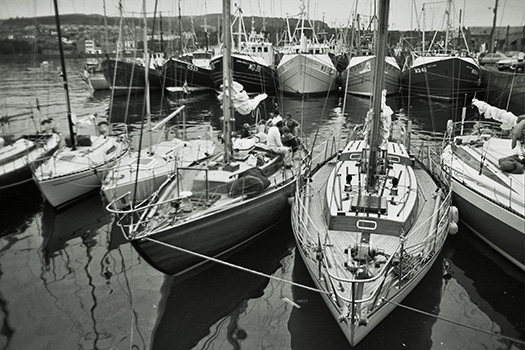 Some of the ISORA fleet during the period when Dickie Richardson chaired the organization during the 1970s. Included in this group sharing Howth Harbour with the fishing fleet in pre-marina days are Philip Watson & Kieran Jameson's J/24 Pathfinder II (third left), the famous S&S 40 Dai Mouse III which is now better known as Sunstone (centre left), and the McGruer 17-ton yawl Frenesi (centre right). Photo: W M Nixon
Some of the ISORA fleet during the period when Dickie Richardson chaired the organization during the 1970s. Included in this group sharing Howth Harbour with the fishing fleet in pre-marina days are Philip Watson & Kieran Jameson's J/24 Pathfinder II (third left), the famous S&S 40 Dai Mouse III which is now better known as Sunstone (centre left), and the McGruer 17-ton yawl Frenesi (centre right). Photo: W M Nixon
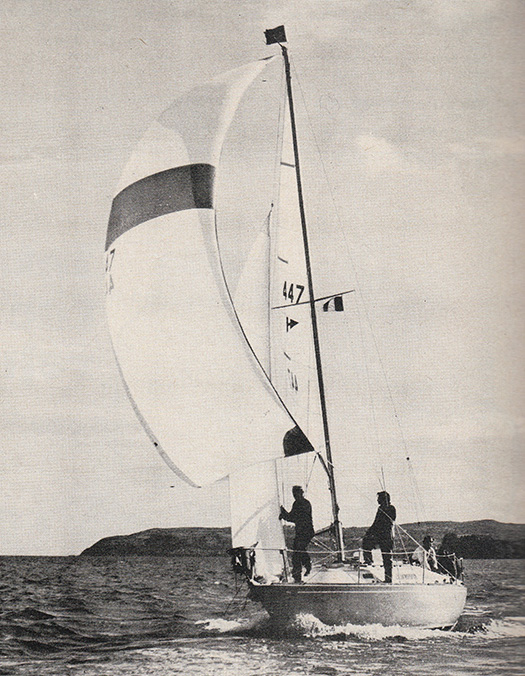 The Richardson's first boat with offshore racing ambitions was the Hustler 30 Skulmartin in 1971, which they finished from a bare hull. They were pioneers in the use of sails made by John McWilliam, who in those days operated under the Tasker label. Photo: W M Nixon
The Richardson's first boat with offshore racing ambitions was the Hustler 30 Skulmartin in 1971, which they finished from a bare hull. They were pioneers in the use of sails made by John McWilliam, who in those days operated under the Tasker label. Photo: W M Nixon
Dickie was to make his own first foray into being an offshore racing owner with the Hustler 30 Skulmartin, which he finished himself from a bare hull. That was his boat when ISORA was founded in 1971, but in late 1973 he bought the almost-new Billy Brown-designed Half Tonner Garland of Howth, which had won her class in the newly-inaugurated ISORA Captain's Cup Week in Holyhead, an event which in time developed into ISORA Week.
Dickie up-graded his new boat with a fractional rig, re-named her Blackwater in line with his policy of having boats named after navigation markers such as lightships in the Irish Sea, and took her in 1974 to the Half Ton Worlds in La Rochelle with a youthful Harold Cudmore as helmsman. In a large fleet they finished eight overall, but it was clear that new designs from Ron Holland and Doug Peterson were the future of offshore racing success. So Dickie and his teenaged sons acquired the bare hull of a Holland-designed Golden Shamrock from the builders in Cork, and finished her to become the Half Tonner Harry Furlong, named after a rock on the north coast of Anglesey.
Their former shipmate Harold Cudmore meanwhile was putting together his own Holland-designed Shamrock campaign with the intensely competitive Silver Shamrock, which duly won the Half Ton Worlds in Trieste in 1976, while back in the Irish Sea the hugely popular ISORA programme was to see Shamrocks in all their variations, Harry Furlong among them, featuring at the front end of the fleet.
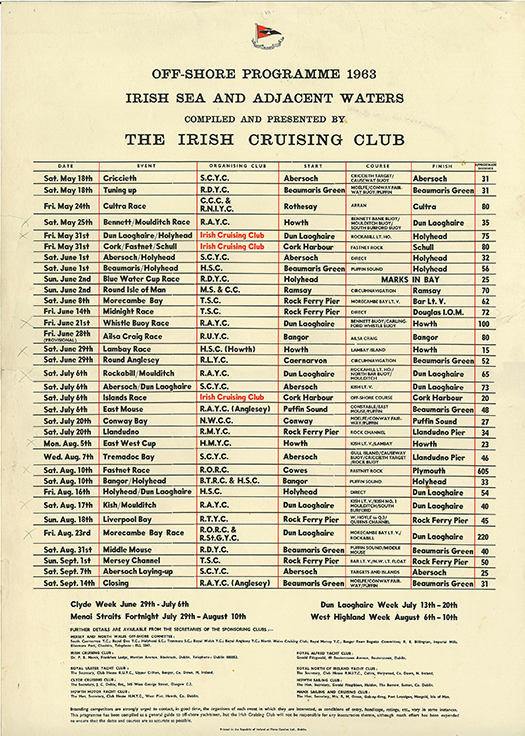
Until ISORA got itself up and running in 1971, all sorts of organisations were involved with distance racing in the Irish Sea. This is a programme issued by the Irish Cruising Club for the 1963 season.
Until Dickie Richardson with others like Hal Sisk from Dun Laoghaire launched the idea of an Irish Sea Offshore Racing Association after the end-of-season Pwllheli-Howth race in 1971, the offshore programme around the area had been fragmented, and date clashes were almost inevitable. Many organisations – some of them very informal - were involved, with the Irish Cruising Club and the Royal Alfred YC active on the Irish side, while in the north the Clyde Cruising Club interacted with the Belfast Lough clubs to run races across the North Channel. Over on the Welsh and English side, the Mersey & North Wales Joint Offshore Committee had developed into the Northwest Offshore Racing Association, and it was this body – with rapidly increasing numbers, particularly from the Irish side – which became ISORA in 1971 with its remit extending to include when possible events in the North Channel, and the annual Round Isle of Man Race, while also including an annual RORC event which might take the fleet to Cork.
What resulted was something which nowadays would be seen as an impossibly crowded and time-consuming programme. But it has to be remembered that times were very different during the 1970s. The Troubles were at their height, and links of friendship across the Irish Sea in a period of active terrorism could be difficult by any means other than a sailing boat. Thus the successful functioning of ISORA was definitely a power for the good, and at its height it had a remarkable fleet of 107 boats from all round the Irish Sea and adjacent areas taking part in its annual season-long championship. Its comprehensive programme, which guaranteed at least seven long weekends of sailing and racing afloat interspersed with friendship ashore in the ports visited, was exactly what people needed in those stressful times.
Inevitably, the challenges of running such an extraordinary and wide-ranging organization on an entirely voluntary basis were enormous, particularly as Dickie Richardson as chairman knew he had to do it with a minimum of fuss. This involved heroic restraint in diplomacy on his part, as normally he wasn't one to suffer fools gladly. Yet with the success of his efforts and those of his committee, for a while the clout of ISORA was such that they were able to hold impressive ISORA Weeks in Cork, Dublin Bay, Cardigan Bay off Abersoch and Pwllheli and even on the Clyde, thanks to their ability to bring a large fleet with them.
But it was all being done in a changing situation. An improved road network in England may have meant that owners from the big inland cities of the north could now reach their boats in Wales more easily, but for some of them an hour or two of extra travel meant they could access boats to race with the RORC fleet from the Solent, which provided modern facilities that far out-stripped the excessively tidal and very primitive harbours of North Wales, and the still-undeveloped ports on the Irish coast.
Then too, because the biennial ISORA Week mopped up all available fleets to one venue, other places felt left out and became more active in promoting their own regattas such as the Scottish Series on Loch Fyne. This clashed directly with the Irish Sea's Round the Isle of Man Race, and it was the latter which faded.
Perhaps most importantly of all, however, social attitudes were changing. The rough and ready approach of it being acceptable for dedicated offshore racing enthusiasts to disappear off for a very long weekend at least seven times a summer, often in order to race an event of barely a hundred miles, just didn't do in the modern family-oriented world.
This led to the introduction by individual clubs of longer events which featured a more clearly defined timescale, with the first biennial Round Ireland Race from Wicklow in 1980, while the National YC's Dun Laoghaire to Dingle Race – also biennial -arrived in 1993.
By that time the annual ISORA programme had been pared down to a more family-friendly scale, but sailing patterns had changed so much, with sunshine holidays afloat in warmer climes rising rapidly in popularity, that just a few years ago there actually was a move for the formal winding-up of ISORA. But happily that was averted, and the basics of the organization are still in being to provide manageable passage races for those who want them, and numbers are now modestly increasing.
Meanwhile for Dickie and Elspeth Richardson and their boys, in the late 1970s the focus of family life had increasingly moved towards their second home in Holyhead, while the pressure on the accelerator for offshore racing achievement was eased early in 1977 with the acquisition of the bare hull of an elegant Ohlson 38 which duly filled the front garden at Eshe Road North in Liverpool.

The new Ohlson 38 Matthew Walker off Holyhead SC (where Dickie Richardson had been Commodore) in 1977. Less than six months earlier, she'd been a bare shell in the Richardson's front garden in Liverpool. Photo: W M Nixon
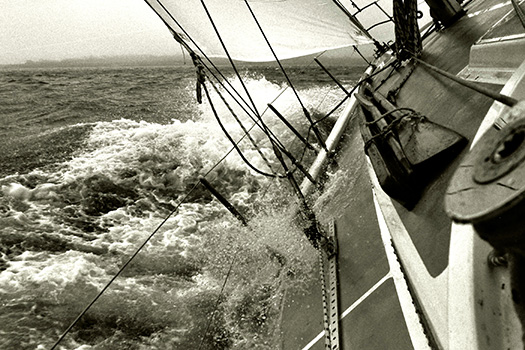
Ready and willing. Despite the rapidity of her completion, Matthew Walker in full commission to cruise to southwest Ireland within six months of the Richardson family taking delivery of the bare hull. Photo: W M Nixon
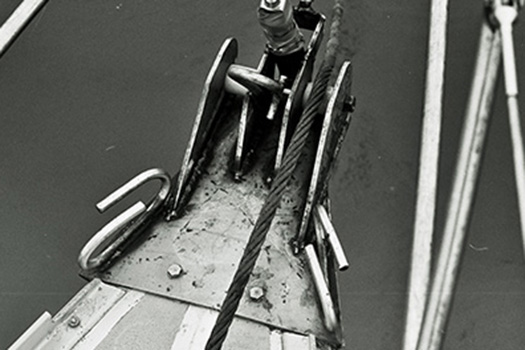
Classic Richardson work. In the summer of 1977, the stemhead fitting on Matthew Walker, which Dickie Richardson fabricated himself, still needed a bit of cosmetic work. But it did what was needed for the first cruise. Photo: W M Nixon
There was a longterm plan to re-emphasise their interest in cruising, but being the Richardsons, once the job was there to be done, it had to go ahead at great speed, for the hull had been delivered late. The new boat – called Matthew Walker – was put afloat in time for a summer cruise to southwest Ireland in the summer of 1977. Though she was still fairy basically finished in some areas, that could be sorted in time. But meanwhile she was certainly ready for sea and Dickie – after a final rush of work on the boat which saw him put in a seven day non-stop work programme – was sent below by his family to sleep as they cleared Holyhead Harbour. He woke up 48 hours later off the coast of West Cork.
In his work as a medical consultant, he was also always prepared to go the extra mile to achieve results, and in his Liverpool days he'd been on the Project Management Committee getting the huge new hospital into commission. He put in so much of his own time on this that when the massive facility finally opened, his sailing friends assumed that he'd be rewarded in some way in the British Honours List. But the word from within was that, in the quest to get the hospital up and running, he'd been so blunt abut the inadequacies of official management that he'd offended far too many NHS sensibilities to have any chance of receiving that well-earned gong.
On retirement Dickie and Elspeth moved to Porth y Fellyn in the almost rural western corner of Holyhead Harbour where they'd converted a former Methodist Chapel into a hospitable home for sailors in which they particularly valued their proximity to Holyhead Sailing Club, where he had served as Commodore, and frequently did duty as a Race Officer while being much involved with training and junior sailing, particularly through a thriving Optimist class.
Another project which suited his talents was done in concert with his longtime sailing friend Alan Stead, another sea-minded Liverpool anaesthetist who had also retired to the Holyhead area. They managed to secure a lease on some space on the inner part of Holyhead breakwater, got themselves an old crane, and offered DIY lay-up facilities to local boats in much the same style as Tower Quay in Birkenhead in the old days.
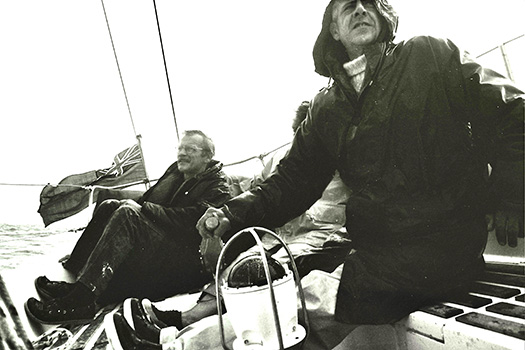
A man enjoying his new boat. Dickie Richardson finally relaxes aboard Matthew Walker after getting her completed and ready for sea in record time. On the helm is his old friend and fellow Tranmere SC stalwart Bert Whitehead, who was Honorary Treasurer of ISORA in the challenging early days. Photo: W M Nixon

Senior sailor. A recent photo of the late Dickie Richardson. Photo: Holyhead SC
In his own sailing, Dickie threw himself into cruising the Ohlson 38 Matthew Walker with the same enthusiasm he'd devoted to offshore racing, and the Rias of Northwest Spain and the islands of the Outer Hebrides became favourite destinations. As for his talented sons, in their late teens and early twenties Angus and William did a spot of yacht design and building, the tiny and very attractive wishbone ketch Poacher being one of their products. But then William, like his younger brother Michael, went on to qualify as an advanced oil drilling engineer, and when the boys were home on leave from distant oilfields, Dickie particularly enjoyed discussion of the specialist techniques they had to use in a technically demanding profession.
Elspeth died in Holyhead on Christmas Day 2010, aged 86, and sadly for Dickie, he was also pre-deceased by his eldest son Angus in 2011. He himself soldiered on until January 2015. He would have much enjoyed his own funeral – it was a classic of its type. And should anyone suggests that the 1970s were a dull decade, rest assured they were no such thing when Dickie Richardson was around and firing on all cylinders, gruffly full of ideas and schemes and bubbling with his own quiet can-do enthusiasm. It was always a lively time in the Richardson orbit.
WMN
2015 Sailing Calendar Includes Two Bicentenaries & Ireland's Biggest Regatta At Dun Laoghaire
Irishsailing – After the remarkable across-the-board success of the 2014 Irish sailing season, 2015 will have to be very special indeed to be remembered with such enthusiasm. But it's a special year in any case, as two major sailing Bicentenaries – one in the Irish Sea, the other in the Solent – will have added and poignant meaning, as the Centenaries a hundred years ago could not be celebrated because of the First World War.
As for Irish sailing generally, life moves on, there are new sailors on the water, successful young sailors are graduating to the next stage of their rapidly developing careers, and established stars continue to plan fresh campaigns, for sailing is indeed a sport for life.
Then too, new fixtures successfully introduced in 2014 will require nurturing, tuning and encouragement if they are to fulfil their potential in the coming year, while at the same time there's always extra effort needed to give proper support to established fixtures, which have to live with the reality that they might wilt through being taken for granted. Both new and longer-established boat classes will need continued enthusiastic involvement, and our well-loved classics and traditional craft must be cherished and sailed, for lack of use is the real enemy of boats, whether old or new.
As for the major administrative initiatives introduced in 2014, they will need constant monitoring, but deserve full support from the sailing and boating community at large, for it was in response to a grass-roots initiative that the radical and very necessary reforms of the Irish Sailing Association were undertaken. Those appointed to undertake the root-and-branch reform of the national authority have done so with commendable dispatch, so it is now the duty of the rest of us to support their continuing efforts. And we can best do that by enjoying our boats and our sailing and time afloat in its myriad of interests, while encouraging others to do the same. W M Nixon outlines on what the coming year may bring.
One thing at least is certain for the coming season afloat during 2015 in most of Europe. It will not mark any significant sailing Centenaries. Instead, we are immersed in four years of remembering the Great War of 1914-1918 a hundred years on, with all the added twists of that period's longer historical narrative in Ireland. In such a context, it may seem frivolous to point out that sports like yachting have no great Centenaries to mark at all in 2015. But this minor off-screen fact is a reminder of the all-involving horror and obscenity of total warfare on an industrial scale. It obliterated anything like normal life.
Yet as recreational sailing had been going on in some sort of organised form for hundreds of years – albeit in a fairly rudimentary way in its earliest years in the 16th Century – there may well have been several important dates to be marked during the time of the Great War itself, but they were allowed to pass as there was no sport afloat, while civilian life ashore was very subdued.
And in Ireland, with the Troubles persisting for four years after the end of the Great War until 1922, the Bicentenary of the Royal Cork Yacht Club in 1920 was to be a muted affair – the official History of the Royal Cork Yacht Club (published 2005) tells us: "Plans for a special dinner to celebrate the club's bicentenary in 1920 had to be cancelled, probably because of the disturbed conditions in the country"
So the idea of celebrating the Centenary of the Royal Yacht Squadron in Cowes in 1915 at the height of the international war - other than in a rather solemn shorebound way - would have been unthinkable. But that in turn fuels the celebrations when the peacefulgood times roll again. Thus the Royal Cork Yacht Club, having been unable to celebrate its Bicentenary in 1920, went on to have a fabulous two-year Quarter Millennium celebration in 1969-70. And as the RYS couldn't have a proper party in 1915, there's no doubt that the up-coming Bicentenary in 2015 will be the nucleus of international sailing's megafest-of-the-year.
There are of course several clubs which pre-dated the Squadron when it was founded in 1815. And there are many whose members outshine the small membership of the RYS in the breadth and energy of their sailing. But for 2015, let's just acknowledge that the prestigious Squadron has been at the heart of sailing history for a very long time, while their clubhouse's location right on the Solent at Cowes is so central that when any great Solent-related events are under way, the Squadron is in the middle of the story.
Thus it was on the Squadron lawn that in July that the Irish team celebrated their epic Commodore's Cup victory at the end of July 2014. And it will be towards the Squadron and its Bicentenary that the fleet will be racing in 2015's west-east Transatlantic Race. And then it will be the firing of the cannons from the historic Squadron battery which will signal the start of the 46th Fastnet Race on 16th August 2015.
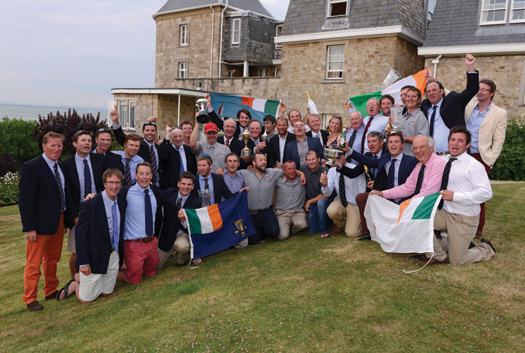
Party time at the Royal Yacht Squadron – the Irish team and their management gather to celebrate victory in the Commodore's Cup at the Squadron Castle in Cowes on August 1st 2014
There'll be many Irish boats involved, and the best-placed of them at the finish will be the winner of the Gull Salver, currently held by Martin Breen's Reflex 38 Lynx from Galway Bay SC, which was skippered to success by Aodhan FitzGerald in 2013's race. It's a coveted trophy, instituted to honour the memory of Harry Donegan of Cork and his famous cutter Gull, which was one of seven boats which inaugurated the Fastnet Race in 1925, and placed third. Since then, Irish Fastneteers have frequently been in the great race's top places, and best of all was in 2007 when Ger O'Rourke's Cookson 50 Chieftain out of Kilrush, sailing under the burgee of the revived Royal Western of Ireland YC, came sweeping in to the finish line at Plymouth to win the Fastnet Race
overall.
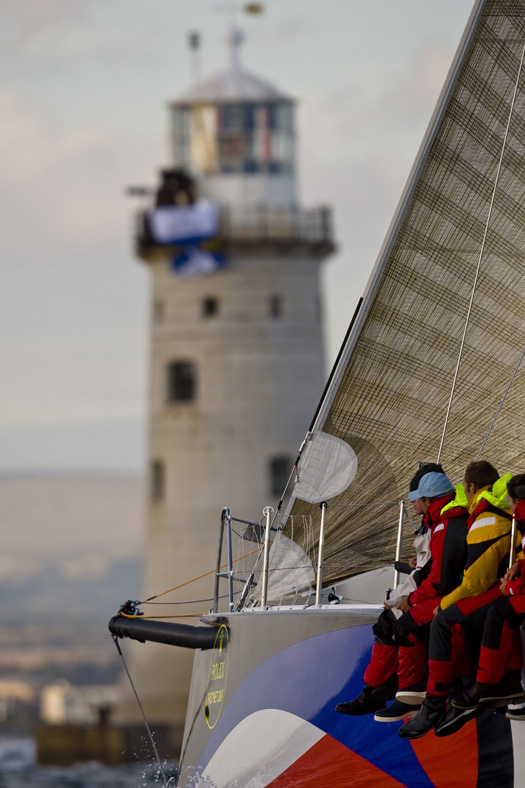
One of the greatest moments in Irish sailing history – Ger O'Rourke's Chieftain sweeps towards the finish line to become the overall winner of the Rolex Fastnet Race 2007. Photo: Rolex
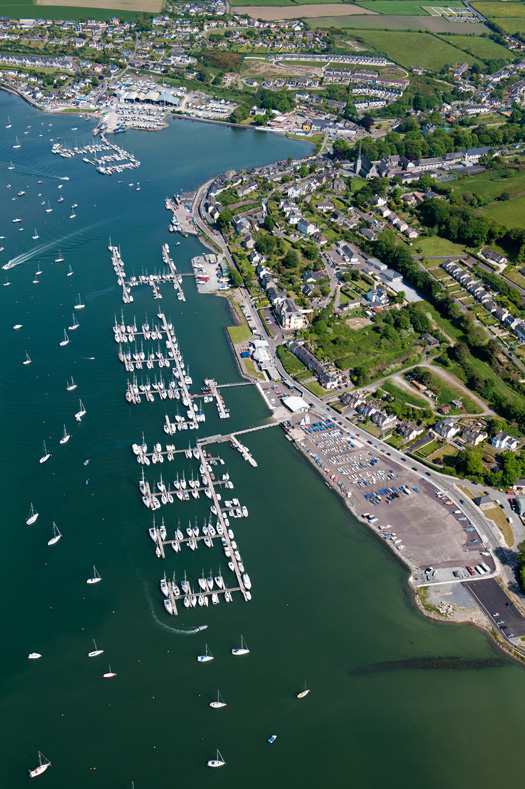
Just the spot for a great Tricentenary celebration - the very complete sailing facilities provided jointly by the Royal Cork Yacht Club and Crosshaven will become a world focus in 2020 with the Club's 300th anniversary. Photo: Bob Bateman
The realisation that 2015 sees this significant RYS Bicentenary is a timely reminder that the Royal Cork's Tricentenary is only five years down the line. They're five years which will be gone in a flash, and already behind-the-scenes moves are afoot to ensure that the national sailing programme will properly facilitate the extraordinary anniversary being celebrated in Crosshaven in 2020.
But meanwhile other Irish sailing centres have their own regular programmes to operate in the intervening four years, and in terms of numbers and scale there's no doubt the top event in Ireland in 2015 will be the biennial Volvo Dun Laoghaire Regatta from 9th to 12th July.
Anyone – and there were many - who took part in this unique "suburban sailfest" in 2013 will know that the VDLR has come of age. It's an event which is comfortable with itself while at the same time being always in development and evolution mode. Each staging of this remarkable Dublin Bay happening sees lessons being learnt and implemented even while the multi-class racing is under way on several courses. And in the two year gap before the next staging, the experience gained is closely analysed and the programme refined to further improve the sport in every area.
You get some idea of the sheer depth of racing experience in Dun Laoghaire by noting that the Chairman of the 2015 Committee is Tim Goodbody, with Martin Byrne as Vice Chairman while the Race Director is Con Murphy. And those three sailing megastars are just the peak of a mountain of race administration experience which is being drawn in from all over Ireland to ensure that the fleet of 400-plus boats gets the best sport possible.
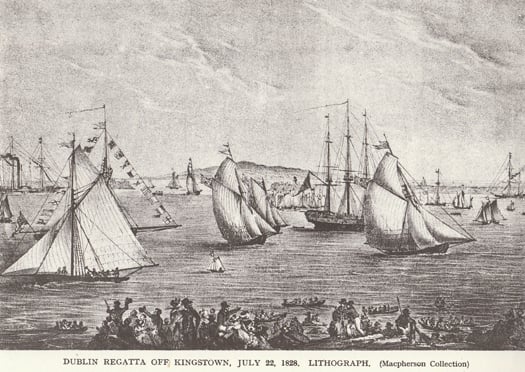
The first regatta in 1828 at the new harbour at Dun Laoghaire, which will be the setting for Ireland's biggest event in 2015, the Volvo Dun Laoghaire Regatta from 9th to 12th July.
While there'll be keenly participating boats from all over Ireland as well as Scotland, England and Wales, the setup of Dublin Bay being right on the city's doorstep means that it's the locals who would pose an administrative problem for a less experienced team. As the dates for the VDLR approached in 2013, the weather forecast steadily improved, and thanks to the Regatta's "extra long weekend" format, the sudden arrival of summer meant that a host of boats from the greater Dublin area came in as last minute entries, their owners and crews managing to scrape the extra day-and-a-half needed off work. It's a scenario which would put an overstretched administration off course, but the VDLR team took it calmly in their stride, and the result was a successful summer festival of sunlit sails and great sport, with maybe two thousand taking part.
This year there's a more structured cross-channel involvement, as the venerable Royal Dee YC in Cheshire has leapt to life to celebrate its Bicentenary. Founded as the Dee Yacht Club in 1815 with the end of the Napoleonic Wars, it didn't get the Royal seal until 1947, but nevertheless claims to be older than the RYS. With growing fleets in North Wales and the Mersey, it has put together a Bicentennial Royal Dee Irish Sea Offshore Championship linked closely to ISORA, which will bring the fleet across to Ireland to take in four offshore day races sailed as part of VDLR 2015.
Irish National Championships which will be part of the VDLR 2015 programme include the J/109s, the RS Elites, the Beneteau First 21s, and the Wayfarers, while the Leinster GP 14 Championship is also included as an integral part of the Regatta.
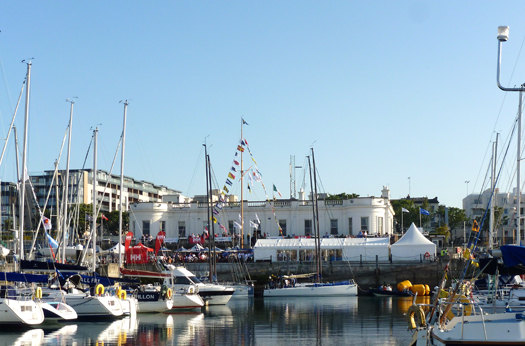
Party time in Dun Laoghaire – the Royal Irish YC during VDLR 2013. Photo: W M Nixon
As for Ireland's classic clinker-built vintage classes, one of the pleasantest surprises in VDLR 2013 was the large turnout of Mermaids, which had superb racing on the course area in the northwest corner of Dublin Bay. Despite having been born as the Dublin Bay SC Mermaid in 1932, this class of 17ft super-dinghies is no longer included in the regular DBSC programme owing to shortage of numbers for weekly turnouts. But it seems that as far as the VDLR is concerned, the Mermaid is now an event boat, and the fleets still thriving at other centres, together with some of the dormant Dublin Bay craft, bestirred themselves for the four days to enjoy good sailing for more than three dozen boats, something which is highly likely to be repeated in 2015.
The even more venerable Water Wags, founded 1887 with the current boats dating from 1903, continue to thrive in Dun Laoghaire, and the word is they expect to have at least twenty boats in action, while another wooden classic, the Mylne-designed 25ft Glen keelboat, is 50 years and more in Dun Laoghaire, and looks forward to having at least twelve boats racing in 2015.
All these specialized and historic classes are in addition to the numerous cruiser-racers which continue to be the backbone of Dublin Bay sailing. And while many of them will see the VDLR 2015 as a highlight of the year, in turning to consider the overall national programme, we find a sport which is shaking off economic recession to get on with an extraordinary plethora of local, national and international sailing events.
The problem is that most events of significance hope to locate themselves in the peak sailing period from late May to early September, so clashes are almost inevitable, and if you're interested in several different kinds of sailing, the overall choices can be bewildering in their complexity and logistical challenges.
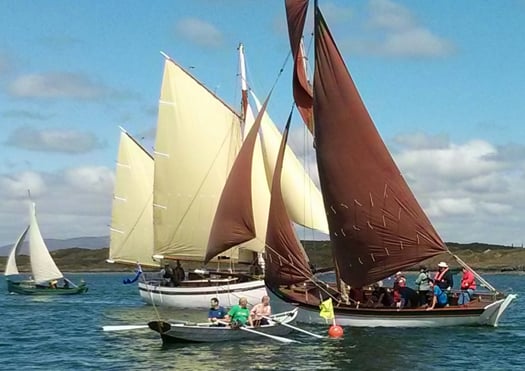
The Baltimore Wooden Boat Festival attracts an eclectic fleet – included here are a Shannon Gandelow, a West Cork Mackerel Yawl, the ketch Sile a Do, and an Heir Island Lobster Yawl (left).
For instance, the variety of events now available for the traditional and classic boats – usually but not necessarily under the Old Gaffer umbrella – would keep anyone busy for most of the summer. It starts with the Baltimore Wooden Boat & Seafood Festival from Friday 22nd May to Sunday 24th May, which you'd think very early
in the season for someone faced with fitting out an old wooden boat in Ireland's climate, but somehow they do it.
Then on the East Coast for the early summer Bank Holiday Weekend from May 29th to June 2nd, there's the Old Gaffer gathering in Dublin Bay at Poolbeg Y&BC with the annual race for the Leinster Trophy in the bay on Saturday May 30th, the event then morphs into the Dublin Port Riverfest in the Liffey on Sunday May 31st, and finally it all concludes with the race for the Asgard Trophy back in the bay on Monday June 1st.
The annual Lambay Race at Howth, a regular fixture since 1904, has seen its course becoming increasingly complex in modern times in order to satisfy the desire of modern racers for competition on every possible point of sailing. But in 2014, to celebrate the Centenary of the Lynch family's Echo, the venerable Howth Seventeens were sent on the traditional course north from Howth Harbour through the sound inside Ireland's Eye, then on round Lambay leaving it to port, and then back south inside Ireland's Eye again to the finish at Howth pierheads.
This was such an attractive proposition for Old Gaffers and Seventeens alike that on the day an extra Classics Division was added to cater for ancient craft, and it hit the spot. This option will be offered again for 2015's Lambay Race (it's on Saturday June 6th), and the word is that Dickie Gomes's 1912-built 36ft yawl Ainmara will be coming down from Strangford Lough to defend her title after 94 years. 94 years? Yes indeed - she won the Lambay Race in spectacular style in 1921 when still under the ownership of her designer-builder John B Kearney.
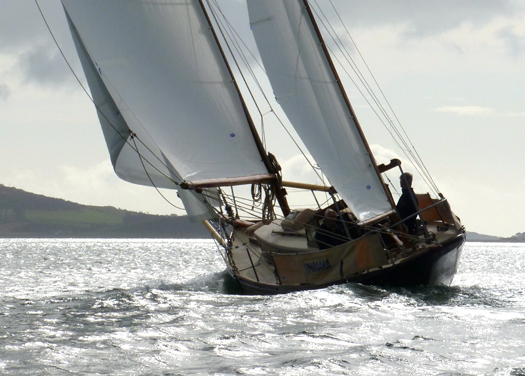
After 94 years, Dickie Gomes's 36ft 1912-built yawl Ainmara (seen here on her home waters of Strangford Lough) hopes to return to defend the title in Howth's Lambay Race, which Ainmara won in 1921 while still in the ownership of her designer-builder John B Kearney. Photo: W M Nixon
The Old Gaffers attention then swings north as the Tall Ships are coming to Belfast from Thursday 2nd July to Sunday 5th July. This is going to be a serious biggie with those ships already signed up including a significant turnout of Class A vessels, which are square riggers and others of more than 40 metres in length. Belfast Lough lends itself particularly well to the Parade of Sail which follows a Tall Ships gathering, and in 2009 when they were last in the port they put in in a virtuoso display with the Dutch ship Europa in particular going to the trouble of getting herself over towards Whiteabbey in the northwest corner of the lough to allow her time get every stitch of sail set before proceeding seawards down-lough in colossal style, a much more impressive display than we've become accustomed to in Dublin, where the shape of Dublin Bay is such that it doesn't really provide the space for square riggers to set all cloth before getting out to sea.
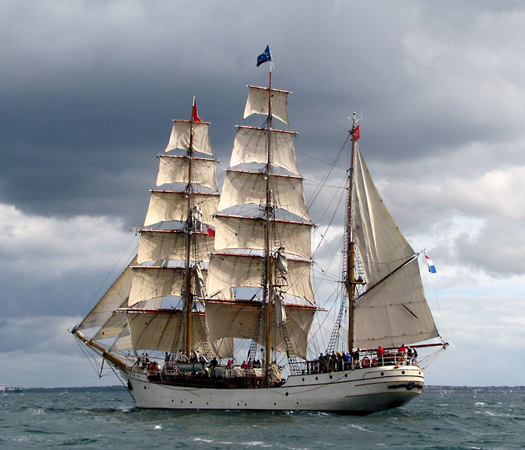
The Tall Ship Europa shows how it should be done in Belfast Lough in 2009, taking time out to set full sail before she starts to gather power to make the proper input into the Parade of Sail.
Like Dublin, Belfast has shown it can be hospitable to Old Gaffers, and it was a very welcoming main port during the OGA Golden Jubilee Cruise-in-Company in 2013, so for 2015 the OGA National President Sean Walsh hopes to up the ante by persuading his members from all round the Irish Sea to gather in Belfast, and to add spice to the mix, he hopes to persuade the Howth 17s to put in an appearance as well, to sail with local one designs like the 1903 Belfast Lough Waverley Class, which have been experiencing a revival in recent years.

Old Gaffers in Belfast for their Golden Jubilee in 2013. The Irish Sea classic and traditional fleet will return to the same venue for the Tall Ships gathering in July 2015. Photo: W M Nixon
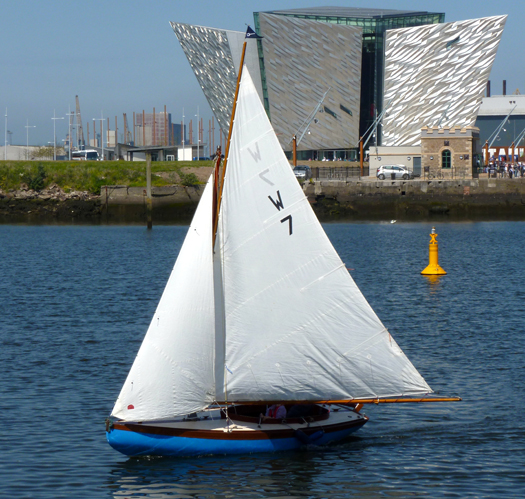
The Belfast Lough Waverley Class Lilias (built 1903) sailing at the Titanic Centre in Belfast. In 2015, the Waverleys will be joined by some of the 117-year-old Howth 17s to participate in the visit of the Tall Ships. Photo: W M Nixon
The Seventeens have made long treks as a class before – in 1998, five of them were road-trailed to Carrickfergus to mark the class's Centenary, with the first five boats built by Hilditch of Carrickfergus. So though they'd trailed there, they then sailed the 90 miles back to Howth, just as the first boats had done a hundred years earlier. Then in July 2003, fifteen of the Seventeens took part in the Glandore Classics Regatta thanks to a brilliantly organised exercise in logistics using a flotilla of low loaders which could take three boats apiece.
For all of Ireland's classic and traditional boats in 2015, and an international fleet too, Glandore is very much up on the radar again, as a special effort is being made by a GHYC team led by Donal Lynch to encourage increased numbers in the CH Marine Glandore Classic Regatta from Saturday July 18th through Friday July 24th. It's a date which certainly allows Old Gaffers plenty of time to get down from Belfast, indeed some may even consider the option of making the voyage northabout to take in a round Ireland cruise while they're at it. And as that great magnet of the Irish Sea classic and traditional scene, the Peel Traditional Boat Weekend, isn't until Friday 31st July to Sunday 2nd August, it's just about possible to factor that in as well.
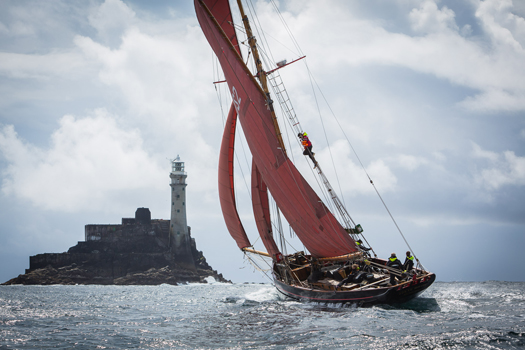
Everything happening at once – the famous Pilot Cutter Jolie Brise was the star of the Glandore Classics in 2013, and as it was her own Centenary she celebrated by sailing round the Fastnet Rock – she has been a successful Fastnet Race participant several times. Photo: Brian Carlin
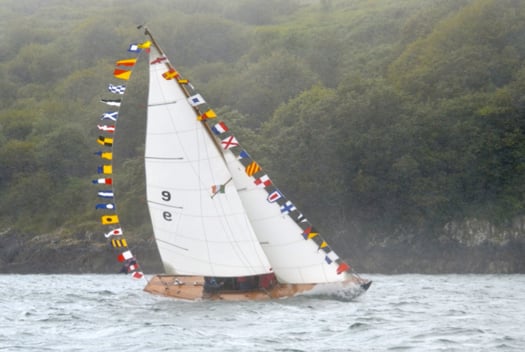
The Glandore Classics attracts an international fleet, and 2013's regatta included a class of Fife One Designs from the Menai Straits, all of them keen to party and showing it. 2015's Glandore Classics is from July 18th to 24th. Photo: Cormac O'Carroll
All this is already happening for the oldies with August barely under way, yet for modern cruiser-racers the potential programme for any keenly-sailed Irish boat is equally complex, attractive and challenging. The season starts as usual with the Scottish Series from Friday 23rd May to Monday 26th May – there'll probably still be snow on the mountains of Arran. They've gone back to their roots by starting with a feeder race from Gourock to the main regatta centre at Tarbert on Loch Fyne. "Going back to the roots" is something of a theme for this year's staging of the Clyde Cruising Club's main racing event, as this is the 40th Scottish Series. Come to think of it, there are so many important 40th anniversaries happening in sailing these days that we have the admit that the decade which brought us the full horror of wide lapels and flared trousers also contributed some lasting elements of the international sailing scene, indeed it could be said that the modern era in sailing really began about forty years ago.
Back in Ireland, the ISORA programme will be well under way by June, while the Lambay Race on June 6th can be looked at with more interest by several boats, as the biennial National YC Dun Laoghaire to Dingle Race doesn't start until Friday June 12th . Last time round, there was a total fixtures clash between the two events, but in times before that hyper-keen sailors such as the Tyrrells of Arklow with Aquelina have been able to fit in both, indeed one year they did it so well they won both too, and were rightly acclaimed as the Afloat "Sailors of the Month" for their success.
For 2015, defending champion in the Dingle Race is Brian O'Sullivan of Tralee with the veteran Oyster 37 Amazing Grace, which came good in the end in 2013 with a new breeze which knocked pending leader Antix (Anthony O'Leary) off the winning perch. But with the 2015 Dingle Race acting as a useful if rather indirect feeder for the Covestone Asset Management Sovereigns Cup in Kinsale from June 24th to 28th, there could be all sorts of sharp boats lining up to take the prize, for the Sovereigns Cup 2015 includes the all-singing all-dancing ICRA Nats 2015.

The welcoming port – Kinsale is one of Ireland's most popular destinations, and in 2015 its hosts the combined Sovereigns /ICRA Nationals from June 24th to 28th.

Perfect sailing – racing in the Sovereigns at Kinsale in June 2013. Photo: Bob Bateman
Yet the timing of the combined Sovereigns/ICRA Nats is such that there's still plenty of time and space to get back to the Irish Sea for the Volvo Dun Laoghaire Regatta 2015 from July 9th to 12th, a reminder that much of the cruiser-racer programme for 2015 is in a neatly balanced and user-friendly timescale for everyone except perhaps those who wish to do either the entire ISORA or SCORA programme as well, so the problem mostly is going to be getting time off work.
And for the hyper-keen cruiser-racers, particularly those whose boats are small enough to be conveniently trailerable, further temptation looms in 2015 with the WIORA Championship at Galway Bay Sailing Club from July 22nd to 25th. For the fleets in the Shannon, on Tralee Bay, and in Clew Bay, it's a bit more than a day's sail away, but they'll be there to challenge Liam Byrne of the home club who won it in 2014 with his Corby 25 Tribal at Mayo SC in Clew Bay, while some top boats from more distant centres are expecting to trail to Galway Bay to spice up the competition.
By this stage of the season a more relaxed pace might be welcome, but the lively turnout of 80 boats in 2014 for the new-style four day Cork Dry Gin Calves Week out of Schull in early August (Tuesday 4th to Friday 7th August in 2015) suggests that for racing sailors, the best relaxation is more racing, but in a holiday setting. And yes, it has been noted that a true West Corkian sailing nut could indeed do all of Calves Week 2015, and still be on the Squadron line for the start of the Fasnet Race nine days later.
For dinghies in 2015, the big story is the debut of the newest version of the National 18, and just how popular will the Bray-bult foiling Moths become, while established classes will frame their programmes to accommodate sailors whose time is limited, also having to fit in with a national scene where the number of Race Officers with the necessary skills is inevitably a finite amount.
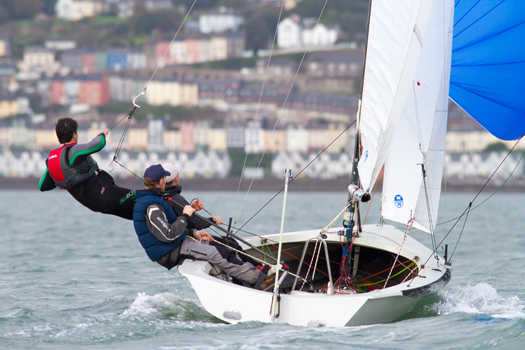
The big stories in Irish dinghy racing in 2015 will be the arrival of the new National 18s at Crosshaven, and the revival of Dinghy Week there in late August. Here, in the Autumn of 2013, To Dwyer and Nin O'Leary test sail the prototype of the new 18 on Cork Harbour. Photo: Bob Bateman
The new Third Generation (or maybe it's fourth or fifth generation) National 18 may have been designed in England by Phil Morrison, and is being built there too. But it was the very active Crosshaven fleet with the Royal Cork Yacht Club which led the charge towards a new boat, and when it came to stepping up to the plate to pay twelve substantial new boat deposits to move it all along after the prototype had been rigorously tested in Cork harbour last Autumn, it was the Crosshaven fleet that provided eight out of those twelve cheques.
So it's entirely appropriate that in August 2015, the dinghy focus will swing big time towards Crosshaven and a short form "Dinghy Week" from August 21st to 23rd. The old style Irish Dinghy Weeks – the last one was in 1970 – became victims of their own success, they just got too large. But the different classes became over-optimistic about their continuing individual growth prospects. Then the pendulum swung too far the other way, and dinghy classes were alone and their events shrinking. But a resurgence of club and championship dinghy sailing in Crosshaven during 2014, and a growing realization that over-reliance on single-handed dinghy classes does not necessarily produce a socially-adjusted national squad of junior sailors, resulted in some clear and creative thinking about developing two-handed boats, and reviving some old classes such as the Mirrors.
The form of this new Dinghy Week is still in the melting pot, but at least eight classes have responded with enthusiasm. Meanwhile, the National 18s in Crosshaven will be such a focus of interest during 2015 with the first of the new boats making their debut that we'll have a season-long dinghy narrative developing on Cork Harbour, and the revived Dinghy Week will be just part of it.
As for inshore keelboats, the big one in terms of number is the combined British and Irish Championship Squib Championship at Howth from 27th June to 3rd July. The handy little Squibs are something of an oddity, as they serve so well as a cherished local class in so many Irish sailing centres that many owners see them as that, and nothing more – handy little club sailors to be raced on home waters a couple of times a week.
This means that when a major regional or national event is held, the number taking part will often only be a fraction of the total Irish Squib fleet. But for those who do make the trek, the competition is fierce and the racing great – in Howth, the high point was in 1996, when this "Nationals" event attracted a fleet of exactly a hundred boats, and on one never-to-be-forgotten morning, there they were, every last one of them on the starting line.

A hundred Squibs all in a row at Howth on Tuesday July 25th 1996. Photo: Mandy Murnane
The most recent Squib event of national stature was the Freshwater Keelboat Regatta at Dromineer on Lough Derg on the weekend of October 18th-19th, and the battle for the top places was between the Kinsale and Belfast Lough fleets, with James Matthews and Rob Jacob of Kinsale rounding out their year in style with a good win.
But with the Squibs in England undergoing a revival – they were the second-biggest One Design fleet in Cowes Week 2014, bested only by the legendary XODs – there's no doubt there's a strong challenge coming across channel, and any Irish boat getting into the top ten will be doing well.
As for that annual Autumn Freshwater Keelboat Regatta at Dromineer, while it may have been much hampered by the spinoff from some ferocious weather out in the Atlantic with frustration for some of the sixty boats hoping to take part, it's an event of enormous potential, and the many who wish it well and have enjoyed it in the past will be ready and willing to do their part to make 2015's regatta a success.

The Squibs enjoying a lull in the strong winds during the Lough Derg Freshwater Regatta 2014. Overall winner was Mucky Duck (no 51, James Matthews & Rob Jacob, Kinsale YC). Photo: Gareth Craig
All these specialised and localized events planned for 2015 will be the continuing background music to the usual events of national sailing focus, everything from the selection of the Irish team for the Student Yachting Worlds to the Helmsmans Championships to the steady increase in pace while 2015 develops as the pre-Olympic year. As the year rolls along, other stories will develop too. So perhaps it's appropriate that we exit this review as we entered it. Just pause to remember now and again that, a hundred years ago, you simply couldn't have gone freely afloat like this for sport and recreation at all.
But we can't close on such a solemn note. Seasoned Solent sailors may have noted our header photo from Guido Cantini at the Panerai Classics Regatta was looking just slightly odd, for some reason difficult to pin down. Well, as it happens, the photo was sent to us back in September just as we were contemplating the excellent cleanup up done by Jason Hurley of Jason Hurley Design on the Mercedes-sponsored billboard photo of Howth 17s on the end wall of Howth Yacht Club. As with many photos taken over the RYS starting cannons, the Cantini pic included an obtrusive part of the Fawley Oil Refinery across on what Isle of Wight people call "the north island". Though Fawley has been there for yonks, it still has the look of a temporary structure. So we got Jason to treat as just that. But here for your edification is the true picture. You could get a taste for this sort of thing. What about brushing out Whitegate, lads? And as for Milford Haven.........
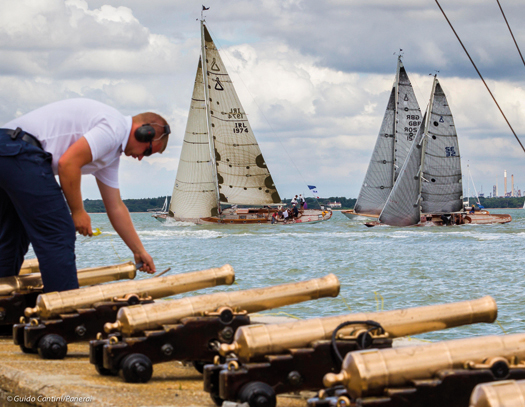
The unvarnished truth. In real life, the view from the RYS battery at Cowes can be slightly marred by the clutter of Fawley Refinery across the Solent on "the north island". Photo: Guido Cantini/Panerai
Read also: 2015 Irish Sailing Fixtures List (provisional)


























